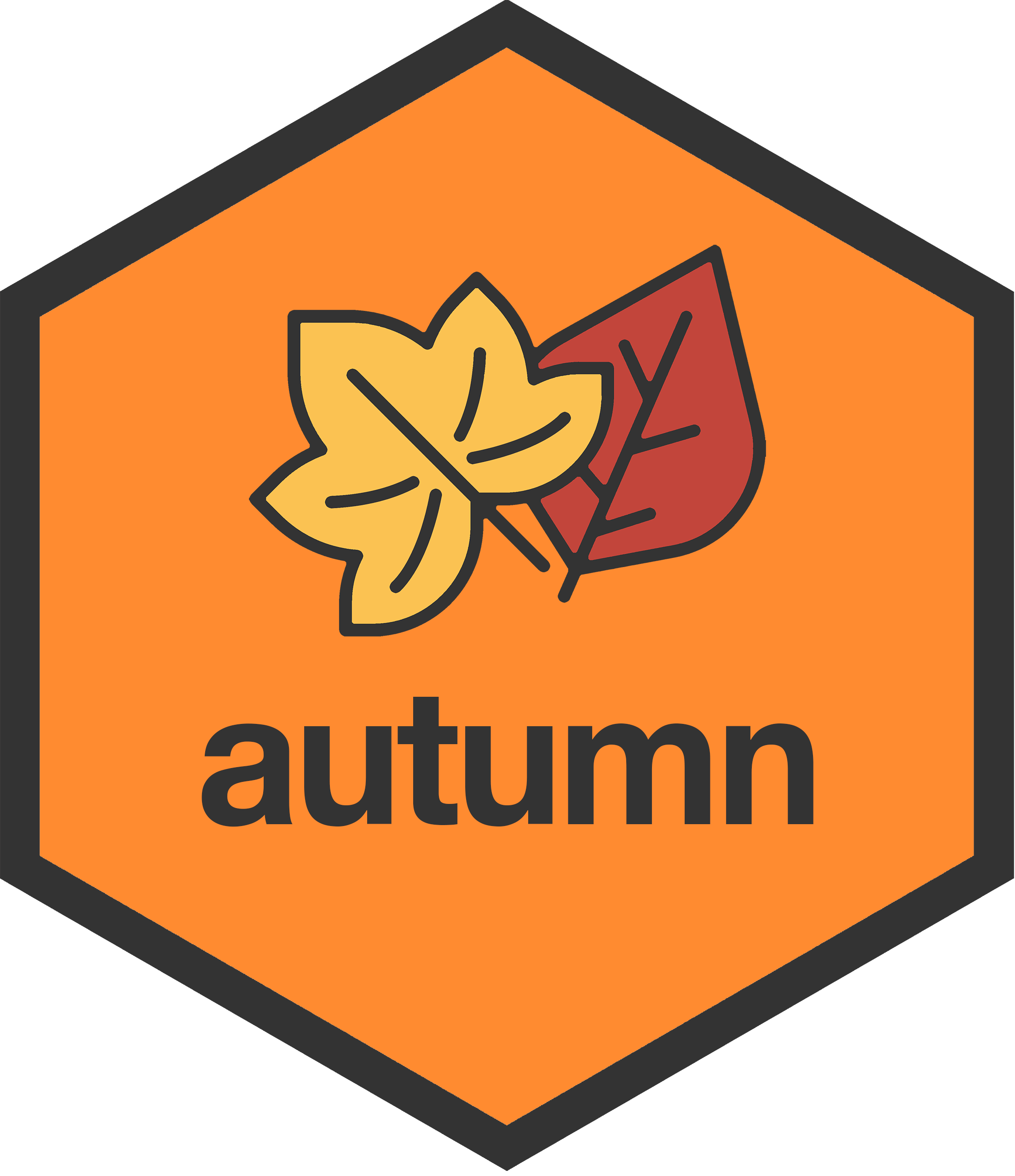autumn: Fast, Modern, and Tidy Raking 
“And as to me, I know nothing else but miracles” - Walt Whitman, probably talking about this package.
Iterative proportional fitting (raking) is a straightforward and fast way to generate weights which ensure a dataset reflects known target marginal distributions: put simply, survey professionals use raking to ensure that samples represent the population they are drawn from.
Existing R implementations of raking are frustrating to use, have
antiquated syntax, require external dependencies or compilation, have
inadequate documentation, generate difficult to understand errors, run
slowly, and don’t support “tidy” workflows. autumn is a modern
package built from the ground up to fix these problems.
Installation
autumn will be submitted to CRAN in January 2020 June 2020. In the meantime,
you can install it using the following command:
# Install GitHub version:
devtools::install_github("aaronrudkin/autumn")Usage
The workhorse function of autumn is harvest(), which takes at
minimum two arguments: 1) a data.frame (or tibble) containing data; 2)
target proportions. At its simplest, a call to harvest() works as
follows:
# Standard R function call
harvest(respondent_data, ns_target)
# Using `magrittr`'s pipe operator
respondent_data %>% harvest(ns_target)It just works! This function call will iteratively weight observations
to match the target proportions and add a column weights to the data
frame (it is also possible to rename the column or return the weights as
a vector). Default parameters are helpful and sane: weights are
guaranteed mean 1 and maximum 5.
Specifying a Target
The main challenge when running harvest() is to correctly specify
target proportions. Two formats are supported: 1) a list of named
vectors; 2) a data.frame or tibble.
When supplying targets as a list of named vectors, it looks like this:
list(
gender = c(Male = 0.4829, Female = 0.5171),
region = c(Midwest = 0.2086,
Northeast = 0.1764,
South = 0.3775,
West = 0.2374)
)Each list element should match the name of a single variable in the data, and each vector name should match a value the variable can take. The numeric values should be positive and sum to 1 within each variable.
When supplying data as a data.frame or tibble, the data.frame should
have three columns (by default harvest() looks for columns named
“variable”, “level”, and “proportion” – although these names can be
overridden):
target_tbl
#> # A tibble: 6 x 3
#> variable level proportion
#> <chr> <chr> <dbl>
#> 1 gender Male 0.483
#> 2 gender Female 0.517
#> 3 region Midwest 0.209
#> 4 region Northeast 0.176
#> 5 region South 0.378
#> 6 region West 0.237Advanced Usage
autumn supports a variety of advanced features including:
- Supplying starting weights
- Adjusting maximum weights
- Adjusting convergence and iteration criteria
- Adjusting variable selection and error calculation criteria
- Handling missing data appropriately
- Calculating design effects for produced weights
- Summarizing raking results
Interested in doing something fancy? Check out our R vignettes for more details: TODO VIGNETTES GO HERE
Speed 🚀
How fast is autumn? Fast.
Below, we present results of three different benchmark scenarios, each
using real data (the first two benchmarks use the respondent_data and
ns_target datasets included with autumn). All of these benchmarks
use identical data and default parameterizations, and were run on a low
power 2016-vintage personal computer. The larger the the dataset and the
more complicated the rake, the more you benefit from using autumn.
Customizing convergence criteria to allow for earlier termination can
result in further speed improvements over existing software.
Note:
Small scale
This benchmark generates weights for a dataset of 6,691 observations, raking on 10 variables. Compared with the implementation in anesrake, autumn is about 67% faster and allocates one third less memory. Compared with the implementation in survey, autumn is about 4X as fast and allocates 20% more memory.
#> # A tibble: 3 x 6
#> expression min median `itr/sec` mem_alloc `gc/sec`
#> <chr> <bch:tm> <bch:tm> <dbl> <bch:byt> <dbl>
#> 1 autumn 1.35s 1.73s 0.572 738.35MB 3.01
#> 2 anesrake 2.46s 2.89s 0.315 1.11GB 2.42
#> 3 survey 4.57s 6.76s 0.148 614.84MB 0.866
Medium scale
Consider a raking task that is more difficult to converge: the same dataset (6,691 observations) raked on 17 variables. The extra variables involve interactions which greatly complicate convergence. autumn is three times as fast as anesrake and uses almost two thirds less memory (survey will not complete the rake):
#> # A tibble: 2 x 6
#> expression min median `itr/sec` mem_alloc `gc/sec`
#> <chr> <bch:tm> <bch:tm> <dbl> <bch:byt> <dbl>
#> 1 autumn 2.3s 3.02s 0.327 1.22GB 6.58
#> 2 anesrake 8.41s 9.99s 0.0945 3.11GB 4.77
Large scale
Finally, consider an extremely resource intensive problem: raking a much larger dataset of 108,660 observations on 17 variables. In this scenario, autumn is 11 times faster and uses 92% less memory. (This benchmark is limited to 10 iterations):
#> # A tibble: 2 x 6
#> expression min median `itr/sec` mem_alloc `gc/sec`
#> <chr> <bch:tm> <bch:tm> <dbl> <bch:byt> <dbl>
#> 1 autumn 47.1s 48.8s 0.0200 20.8GB 2.44
#> 2 anesrake 8.15m 8.8m 0.00189 238.6GB 2.52
Why is the package called “autumn”?
Authorship and Funding
autumn is written and maintained by Aaron
Rudkin. Target proportions in the
included ns_target data were developed by Alex
Rossell-Hayes.
If you have any comments, issues, or concerns, please open a GitHub issue. Contributions are welcome. Please see our Contributor Code of Conduct for details.
autumn was developed in conjunction with Democracy Fund + UCLA Nationscape, one of the largest public opinion surveys ever conducted. UCLA’s Nationscape team are: Tyler Reny, Alex Rossell-Hayes, Aaron Rudkin, Chris Tausanovitch, and Lynn Vavreck. Funding for this project was provided by Democracy Fund, part of the Omidyar Group.
Package hex logo adapted from art by Freepik from flaticon.com

